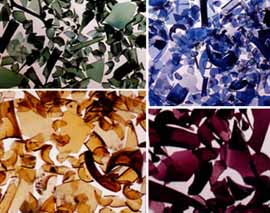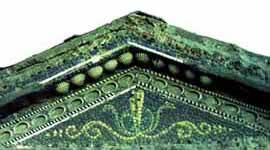|
Monochrome Cullet
Aventicum (modern Avenches), on the Rhine in
Switzerland, was a glassworking center that, like Octodurus,
imported bulk glass ingots from afar. To supplement these
supplies, however, glassworkers there re-melted loads of broken
glassware (cullet) that periodically were carted in
from the local towns and military camps. The workshop's own
immediate debris was recycled as well. Presumably
the end-product again was some kind of ingot. But its color
probably was limited to green—with hues ranging anywhere
from light and blue-tinged to blackened and murky—and
very much an arbitrary blend of whatever went into the melting
pot on any particular day.
Provincial glassmakers were in the market for
cullet because it saved them from having to buy expensive fresh
ingredients from afar. They also were surely aware that finely crushed
cullet, when mixed into a batch of valuable raw materials, would
act as kernels for its fusion, and so encourage a uniform consistency
in the glass stock. Cullet from colored monochrome wares also
was sold directly to mosaic-makers, for use in the decoration of
the meeting rooms of larger provincial cities or of the spas of
luxurious villas in the neighboring countryside.
|
|

Cullet batches recovered
from Avenches
Mid 1st century A.D.

Cornice panel from
a fountain in the courtyard of the Casa del Granduca, Pompeii
First half of the 1st century B.C.
|

